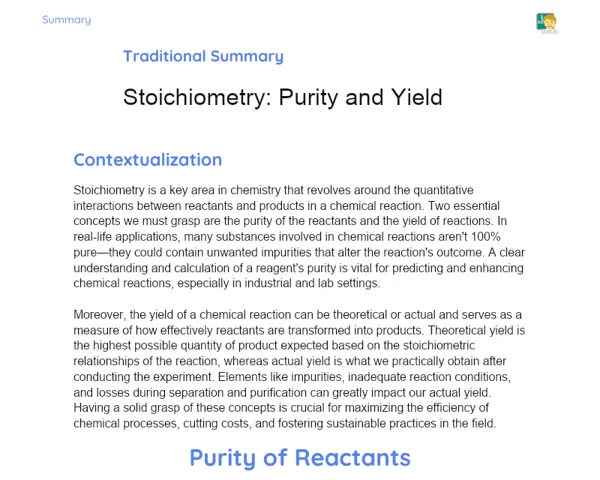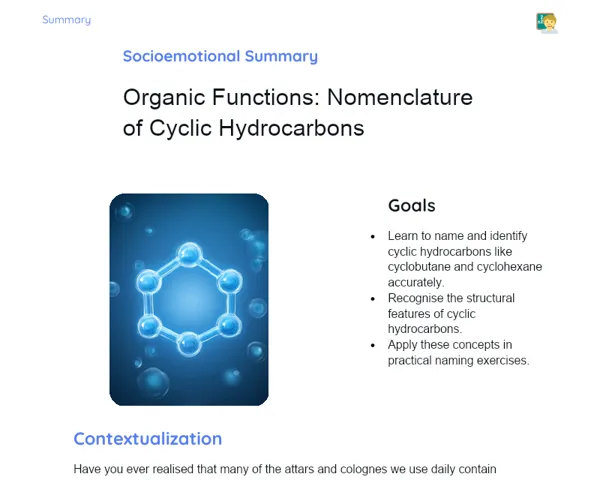Summary Tradisional | Organic Functions: Aldehyde
Contextualization
Organic Chemistry is one of the most engaging branches of science, central to understanding compounds that contain carbon, a vital element for all forms of life. Among the myriad substances studied, aldehydes hold a significant place due to their roles in both nature and various industries. These compounds are defined by the presence of the formyl functional group (-CHO), and they can be found in products ranging from fragrances to preservatives and even in biological processes like glycolysis. An insight into the structure, properties, and reactivity of aldehydes is key for grasping their diverse applications in practical and scientific contexts.
Aldehydes stand out from other organic compounds, such as ketones, mainly due to the position of the carbonyl group (C=O) in their carbon chains. In aldehydes, this carbonyl group is situated at the terminal end, which imparts distinct chemical and physical properties. Understanding this structural aspect is fundamental, as aldehydes are extensively employed in sectors like food and pharmaceuticals. A familiar example includes vanillin, which gives vanilla its characteristic flavour, alongside formaldehyde, a common preservative.
To Remember!
Structure of Aldehydes
Aldehydes are organic compounds featuring the formyl functional group (-CHO). This group comprises a carbon atom linked to a hydrogen atom and an oxygen atom via a double bond (C=O). The formyl group's structure is essential for the reactivity of aldehydes, as the carbon-oxygen double bond creates a region of high electron density that readily participates in chemical reactions.
A defining feature of aldehydes is the position of the formyl group within the carbon chain, which is always found at the end. This crucial distinction sets aldehydes apart from ketones, where the carbonyl group is embedded within the chain. The location of the functional group endows aldehydes with unique chemical and physical traits.
Additionally, the structure of aldehydes enhances their chemical reactivity. Aldehydes are comparatively more reactive than other organic compounds due to the polarity of the C=O bond, which makes the carbonyl carbon more electrophilic and thus more susceptible to nucleophilic attacks.
-
Aldehydes contain the formyl functional group (-CHO).
-
The formyl group is always at the end of the carbon chain.
-
The carbon-oxygen double bond (C=O) contributes to the high reactivity of aldehydes.
Nomenclature of Aldehydes
In IUPAC nomenclature, aldehydes are named by altering the '-o' ending of the corresponding hydrocarbon to '-al'. This system simplifies the identification of aldehydes straight from their chemical structures. For instance, methanal (formaldehyde) and ethanal (acetaldehyde) are names that terminate with '-al', denoting the presence of the aldehyde functional group.
To name an aldehyde using IUPAC rules, you first identify the longest carbon chain containing the formyl group. Subsequently, the chain is numbered to ensure the formyl group receives the lowest possible number. Finally, the '-o' ending of the name of the hydrocarbon is substituted with '-al'.
Moreover, alongside the IUPAC names, many aldehydes are referred to by common names widely accepted in the industrial and scientific community. These common names often originate from natural sources or notable features of the compound. For example, the common name for methanal is formaldehyde, and for ethanal, it is acetaldehyde.
-
Aldehydes are named by replacing the '-o' ending of the corresponding hydrocarbon with '-al'.
-
The longest chain containing the formyl group is identified and numbered to give the lowest possible number to the functional group.
-
In addition to IUPAC nomenclature, many aldehydes have widely used common names.
Physical Properties of Aldehydes
Aldehydes exhibit physical properties that set them apart from other organic compounds. A notable property is their boiling point, which tends to be higher than that of similar molecular weight alkanes due to the carbon-oxygen double bond. However, aldehydes have lower boiling points compared to alcohols since they cannot form hydrogen bonds as robustly as alcohols can.
Another key aspect of aldehydes is their solubility in water. The polarity of the C=O bond enables aldehydes to form hydrogen bonds with water molecules, leading to their general solubility in water. Nonetheless, as the carbon chain lengthens, their solubility decreases due to the increasing influence of the nonpolar portion of the molecule.
Additionally, many aldehydes are known for their strong and distinctive odors. Low molecular weight aldehydes often possess sharp scents and find applications in flavorings and fragrances. A prime example is vanillin, which is responsible for the flavour and aroma of vanilla.
-
Aldehydes have higher boiling points than alkanes but lower than alcohols.
-
They are generally soluble in water due to their ability to form hydrogen bonds.
-
Many aldehydes have characteristic odors used in fragrances and flavorings.
Chemical Reactivity of Aldehydes
Aldehydes are notably reactive because of the presence of the formyl group. The polarity of the C=O bond makes the carbonyl carbon an electrophile, which facilitates nucleophilic addition reactions. During these reactions, a nucleophile adds to the carbonyl carbon, creating new compounds.
A common reaction involving aldehydes is oxidation, where aldehydes readily convert to carboxylic acids under the influence of oxidizing agents. For instance, ethanal can be oxidized to acetic acid. This reactivity is harnessed in numerous industrial and laboratory applications.
Furthermore, another critical reaction is the nucleophilic addition to the carbonyl carbon, which is fundamental in forming various chemicals and is extensively leveraged during organic synthesis. The reactive nature of aldehydes also allows them to form hemiacetals and acetals upon reaction with alcohols, processes vital for numerous chemical transformations.
-
Aldehydes are highly reactive due to the polarity of the C=O bond.
-
Common reactions include oxidation to carboxylic acids and nucleophilic addition to the carbonyl carbon.
-
Aldehydes can form hemiacetals and acetals in reactions with alcohols.
Key Terms
-
Aldehydes: Organic compounds characterized by the formyl functional group (-CHO).
-
Formyl functional group: Unique group found in aldehydes, consisting of a carbon atom bonded to a hydrogen atom and an oxygen atom via a double bond (C=O).
-
IUPAC nomenclature: The system used to systematically name organic compounds, including aldehydes.
-
Physical properties: Attributes such as boiling point and solubility in water that differentiate aldehydes from other compounds.
-
Chemical reactivity: The capacity of aldehydes to engage in chemical reactions due to the polarity of the C=O bond.
-
Oxidation: The transformation of aldehydes into carboxylic acids.
-
Nucleophilic addition: A reaction where a nucleophile attacks the carbonyl carbon of aldehydes, resulting in new compound formation.
-
Hemiacetals and acetals: Compounds formed by the reaction between aldehydes and alcohols.
Important Conclusions
Aldehydes represent a vital category of organic compounds distinguished by the formyl functional group (-CHO). Their differentiation from ketones arises from the carbonyl group's location at the end of the carbon chain, imparting specific chemical and physical characteristics, such as moderate boiling points and solubility in water. The high reactivity of aldehydes is attributed to the polarity of the C=O bond, facilitating reactions like oxidation to carboxylic acids and nucleophilic addition to the carbonyl carbon.
The nomenclature of aldehydes adheres to IUPAC rules, where the '-o' ending of the corresponding hydrocarbon is substituted with '-al'. Besides systematic naming, numerous aldehydes also have common names prevalent in industry and scientific discourse. Familiarity with these nomenclatures is essential for identifying and studying these compounds across different contexts.
Aldehydes prominently feature in various industrial and biological applications. Examples such as vanillin and formaldehyde highlight their significance in fragrances, preservatives, and biological processes. A solid understanding of the structure, properties, and reactivity of aldehydes is imperative for exploring their broad practical and scientific applications, which makes this a pertinent subject in Organic Chemistry studies.
Study Tips
-
Review the structural formulas of key aldehydes and practice IUPAC nomenclature to reinforce your understanding.
-
Study the chemical reactions of aldehydes, such as oxidation and nucleophilic addition, using practical examples and exercises.
-
Research the industrial and biological applications of aldehydes to better appreciate their importance and utility in daily life.



